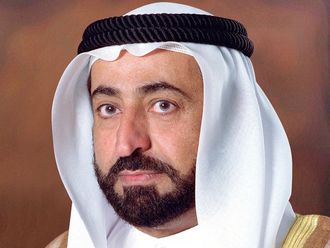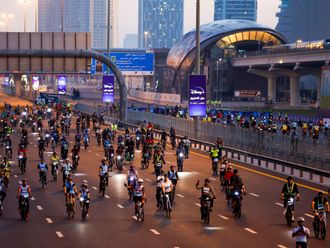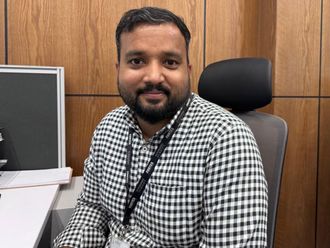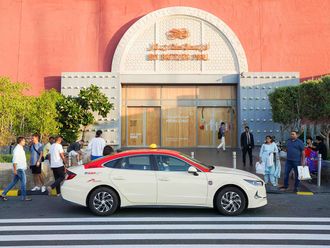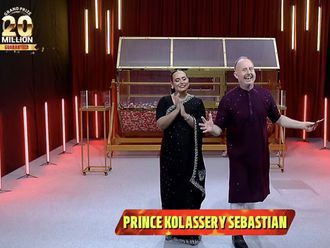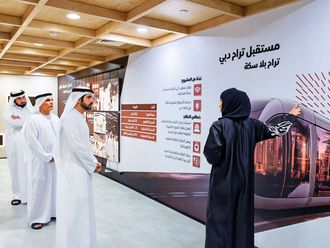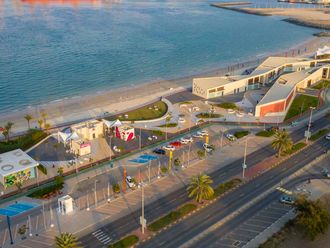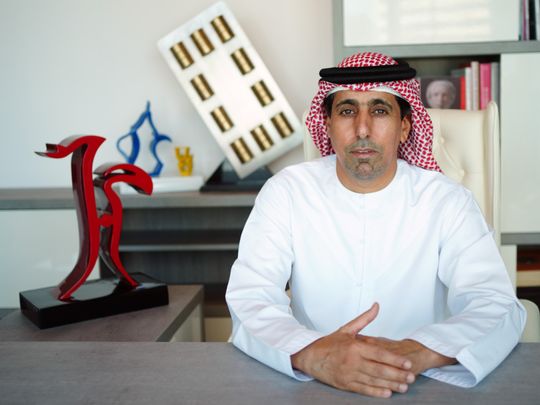
Dubai: Millions of people passing Dubai International Airport will notice a striking red sculpture in Arabic calligraphy titled ‘Love’.
Another one that catches the eye is a gold coloured sculpture, ‘My Dallah’, made out of fiberglass, installed at the arrivals area of Terminal 3. It’s an abstract representation of an Arabian coffee pot and cup, known as the Dallah and ‘Fenjan’, which are important components of UAE culture.
All of these forms and more are part of a series of works by Emirati artist Jamal Haroboush Al Suwaidi.
Al Suwaidi, born in 1971, showed an interest in art at an early age. He began entering art competitions organised in his hometown at the age of 14.
Upon graduating from high school, he enrolled himself in the Sharjah Art Institute and took multiple courses in sculpting, ceramics and calligraphy. He was later awarded for his creativity at Abu Dhabi University in 2010.
“I worked and studied hard to develop my talent. My dream is to make the world know about Emirati artworks,” Al Suwaidi told Gulf News.
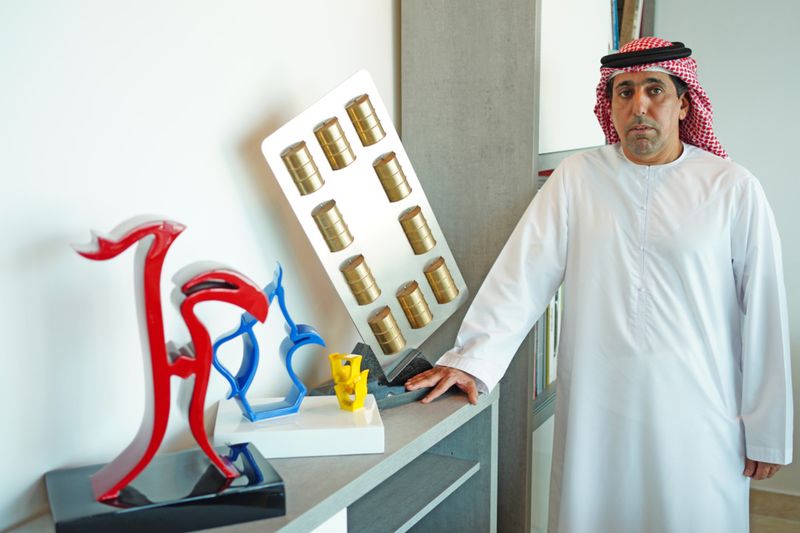
“My work influenced by my relationship with the environment of my birthplace, and the rich history, values and heritage of the UAE.”
One of the unique aspects of his work is the undeniable connection to the UAE environment, where he combines aspects of nature, history and heritage in a single masterpiece.
He likes combining Arabic calligraphy letters with forms inspired by the natural habitat of the UAE, thereby also sharing the beauty of Arabic with others.
The Love series ranks among the artist’s most iconic work, displaying elements that are contrasting, such as the choice of colour, and unifying, like the use of letters, to create the delicately positioned, two or three-pronged form.

The idea for the Love sculpture first came in 2013, when Al Suwaidi was traveling through the desert on a photographic expedition and spotted two Al Ghaf trees that were isolated, yet simultaneously a duo, seemingly providing each other with companionship and support.
“I was inspired by the simplicity of nature in the desert. It occurred to me that love is everywhere and can be found throughout the universe and it travels by true feelings,” he said.
From that scene, he was inspired to make the Love sculpture, which was collected by Dubai Airport and installed at Terminal 1.
“It became a message of love to the world. We welcome the people on arrival as well as say goodbye to the world with love and peace.”
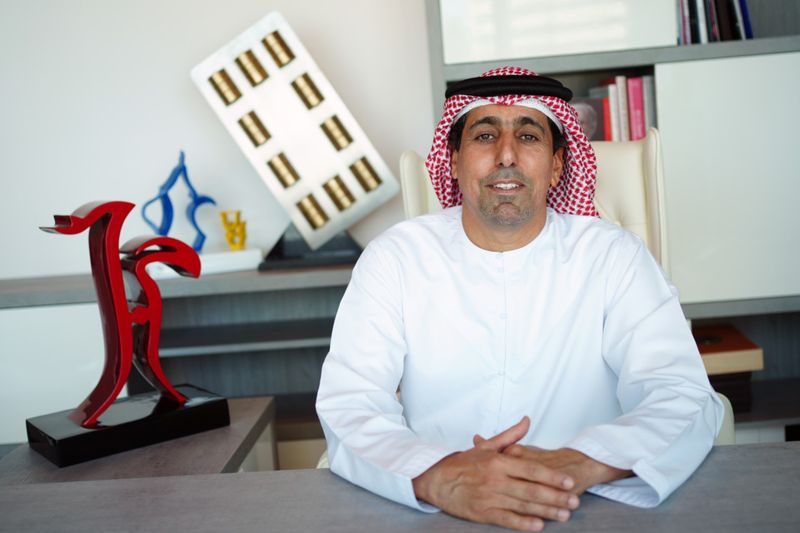
Travelling to many countries made him realise that an artist bears a responsibility to create bridges between different cultures through his art.
He visited Murano Island in Venice many times to study the rich history of glassmaking structures on the Italian island.
“I met many people there and had good relationships, especially with big workshops. They said Arabic calligraphy is difficult in glassmaking, but I managed to make different artworks; glassmaking artworks mixed with the beauty of the Arabic calligraphy,” he said.
Al Suwaidi pointed out that the UAE has provided support to Emirati artists by hosting many art and cultural events as well as having a wide range of museums.
“UAE is a pioneer in different sectors. We have one of the leading museums in the world, such as the Louvre in Abu Dhabi. We have the (soon-to-open) Museum of the Future in Dubai and others in different emirates,” he said.
Collecting and making NFT artworks
A non-fungible token (NFT) is a unique and non-interchangeable unit of data stored on a blockchain, a form of digital ledger. Al Suwaidi said that he noticed the NFT art since the start of the cryptocurrency and digital era. He has been following the development of the NFT market closely and collecting works privately.
“I studied the NFT since 2018. Before I used to collect [physical] artworks and recently I’m a collector of NFT arts,” he said.
Al Suwaidi believes that NFT arts have a meaning and a future just like any other form of art.“It is digital arts quality and specifications encouraged me to collect.”
He has a plan to make his own NFT arts.
“The work on my NFT art is almost done. I’ve been working for two years on it and will display it at a proper time,” he said.
Taking the form of digital assets, NFTs have become a major talking point in the art world in recent years due to several high-value and high-profile sales at auction.
Recent examples that have rocked the industry and confirm that digital art is a collectible to be taken seriously include Pak’s ‘The Switch’ and ‘The Pixel’, which sold for more than $1.4 million and $1.3 million respectively, and ‘Crossroads’, by Beeple (Mike Winkelmann), which fetched $6.6 million.
‘Antibiotic’ artwork
Al Suwaidi latest artwork , called ‘Antibiotic’, shows a tablet of medicine where barrels of petrol replace the antibiotic pills.
“It is a critique work and has a philosophy. It combines the medicine and petrol barrel to show medicine companies and how they trade with it,” said Al Suwaidi.
His new work explores the complex and at times “conflicting roles” that antibiotics play by providing crucial treatment for the sick, while delivering huge rewards to the powerful drug manufacturing and pharmaceutical industries.
Another meaning is about countries known for being rich in petrol that during the COVID-19 crisis played a major role.
“It represents countries known of being rich in petrol like the UAE which during the pandemic harnessed its resources and petrol to overcome COVID-19. UAE sent aid to many countries during the pandemic which shows the good will of the country in aiding others,” he added.
‘Water Pump’ artwork
One of the favourite artworks of Al Suwaidi is titled ‘Water Pump’.
A green old water pump structure inspired by the late Sheikh Zayed bin Sultan Al Nahyan, founder father of the UAE.
Al Suwaidi said that he wanted to represent Sheikh Zayed’s vision of transforming the desert into green lands.
“Late Sheikh Zayed had a big challenge of creating a viable agriculture industry in the desert. He insisted and believed that he could overcome the challenge. In that time water pumps were spread widely in the country,” Al Suwaidi said.
Dating back to the 1960s and operating through the 1970s, the iconic pumps were considered to be among the most important agricultural equipment for farmers, enabling them to extract water through pipes from underground wells that they could then use to plough their land and grow crops.
He was also inspired by key physical aspects of the pumps, including its resemblance to a film reel – an element that he built upon by exploring the documental component of the machine.
“The water pump’s coincidental similarity to a film reel clipart is significant since, in many ways, it not only forms a key part of the early history of agriculture but does indeed tell its story,” he said.
“The water pumps that poured water into the desert became a cinematic tool telling the story of late Sheikh Zayed.”
‘Martyr’s Helmet’
Another iconic work by Al Suwaidi is a tribute to those who made the ultimate sacrifice for their country.
The Commemoration Day provides a timely opportunity to highlight a very special piece of work, which was created to mark the first Martyr’s Day in the UAE, held on November 30, 2015 in Abu-Dhabi.
The artwork, created in stainless steel and reminiscent of traditional, military-style headwear, bears the immediately recognisable four colours of the country’s national flag.
Created in a series of delicately curved lines that remind us of the artist’s passion for bringing calligraphy into his work, the helmet is evidently meticulously researched and familiar in shape.
“A helmet is symbolic in so many ways, providing protection in just the same way that our martyrs did when they laid down their lives for their country and its people,” he said.
“This work is a lasting legacy to both the people who lost their lives while serving their country and also the occasion of Commemoration Day itself. Those who have been martyred will always be remembered.”




